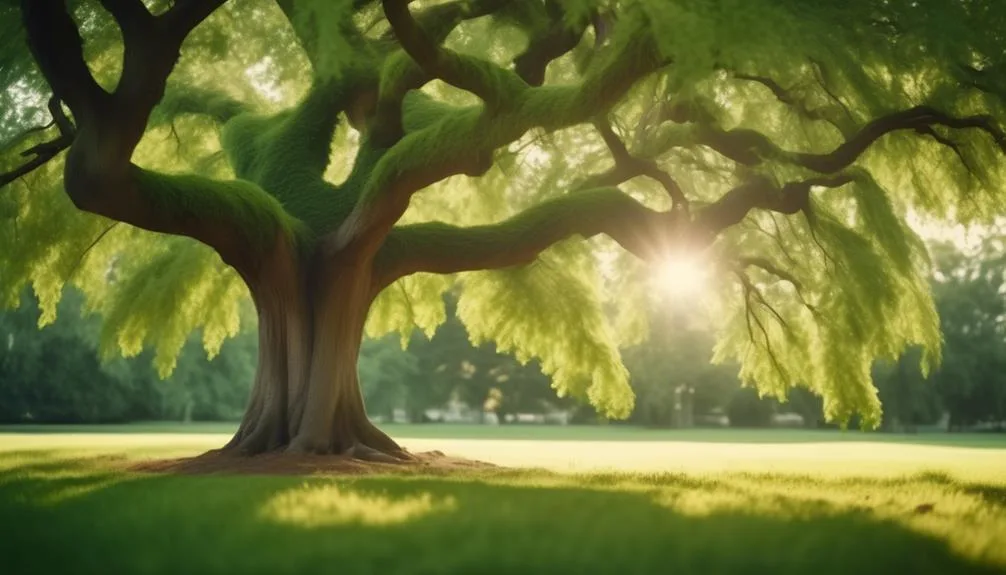Imagine walking through a peaceful garden with the gentle rustle of leaves and dappled sunlight. Now, envision this scene with majestic elm trees.
Elm trees add beauty and practical benefits to any outdoor space, from providing shade and privacy to increasing property value. They are a timeless and versatile choice for landscape design, offering even more advantages.
Elm Trees: Aesthetic Appeal
When you walk through a garden or a park, elm trees stand out with their graceful, arching branches and distinctive, serrated leaves, adding a timeless and elegant charm to the landscape.
Throughout the seasons, elm trees undergo beautiful transformations, from the fresh, vibrant green of spring to the rich, fiery hues of autumn. Proper care for elm trees is essential to maintain their aesthetic appeal.
Regular watering, especially during dry spells, and occasional fertilization can help keep elm trees healthy and vibrant. Pruning in late winter or early spring can ensure their graceful form and encourage new growth.
Additionally, preventive measures against diseases such as Dutch elm disease are crucial for preserving these stunning trees. By understanding seasonal changes and providing proper care, elm trees can continue to enhance the beauty of any outdoor space.
Elm Trees: Environmental Benefits
Elm trees contribute significantly to the environment by providing shade, improving air quality, and supporting biodiversity in urban and rural landscapes alike.
Their large, dense canopies offer cooling shade, reducing the urban heat island effect and lowering energy costs.
Elm trees act as natural air purifiers, filtering pollutants and releasing oxygen, thus improving overall air quality.
Additionally, they provide vital habitats for birds, insects, and other wildlife, thereby supporting urban biodiversity.
Elm tree conservation efforts are crucial to safeguarding these environmental benefits.
Urban tree planting programs often prioritize elm trees due to their resilience and capacity to thrive in diverse environments, further enhancing the ecological impact of these majestic trees.
Elm Trees: Low Maintenance
Low maintenance elm trees require minimal care and upkeep, making them an ideal choice for landscaping and urban environments. Elm trees are known for their low water requirements and drought tolerance, reducing the need for constant watering and maintenance. This makes them perfect for busy homeowners or city planners looking for sustainable and hassle-free landscaping options. Take a look at the table below to see just how easy it is to maintain elm trees compared to other popular landscaping options.
| Maintenance Aspect | Elm Trees | Other Trees |
|---|---|---|
| Water Needs | Low | High |
| Pruning Frequency | Moderate | High |
| Pest Resistance | High | Low |
| Soil Adaptability | Versatile | Limited |
| Overall Maintenance | Low | High |
With their low maintenance requirements, elm trees offer a beautiful and practical solution for any landscape design.
Elm Trees: Shade and Privacy
With their low maintenance requirements, elm trees not only offer practical landscaping solutions but also provide excellent shade and privacy for outdoor spaces.
The broad, dense canopy of elm trees creates a cool and inviting area underneath, making them perfect for shading patios, decks, and outdoor seating areas. This natural shade not only offers relief from the sun's intense rays but also helps to lower outdoor temperatures, creating a more comfortable environment for relaxation and entertaining.
Additionally, the dense foliage of elm trees provides an effective barrier, offering privacy from neighboring properties or busy streets. Whether you're looking to create a secluded retreat in your backyard or simply want to enjoy a shaded outdoor space, elm trees offer unparalleled shade benefits and privacy advantages, making them a valuable addition to any landscape design.
Elm Trees: Property Value Boost
Enhancing your property with elm trees can significantly increase its market value and overall appeal. Elm trees aren't only aesthetically pleasing but also add to the curb appeal of your property.
Research has shown that homes with well-maintained and strategically placed trees, such as elm trees, tend to have higher property values. The shade and visual interest provided by these trees can make your property stand out and attract potential buyers.
Elm trees also have a reputation for longevity and resilience, which can further contribute to the perceived value of your property. Additionally, the lush green foliage of these trees can create a sense of tranquility and natural beauty, enhancing the overall desirability of your property.
Conclusion
Incorporating elm trees into your landscape offers a blend of beauty, low maintenance, and environmental benefits.
Enhancing your outdoor space with these trees not only provides shade and privacy but also contributes to a healthier ecosystem and potentially increases your property's value.
How might adding elm trees transform your outdoor environment? Consider these benefits as you envision a more functional and aesthetically pleasing landscape.

My interest in trees started when I first saw the giant sequoias in Yosemite.
I was a teenager then, and I remember thinking, “I need to learn more about this.”
That moment stuck with me.
A few years later, I went on to study forestry at Michigan Tech.
Since graduating, I’ve worked in a mix of hands-on tree care and community education.
I’ve spent over ten years helping people understand how to plant, maintain, and protect the trees in their neighborhoods.
I don’t see trees as just part of the landscape.
They are living things that make a real difference in our daily lives.
